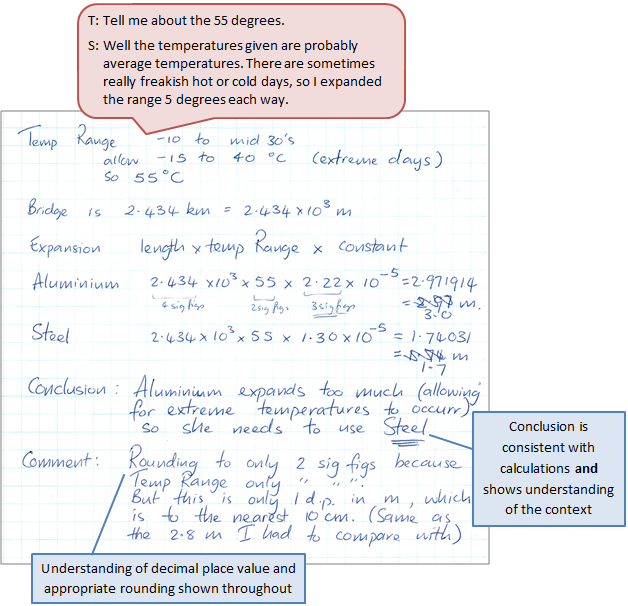The purpose of this activity is to engage students in using their knowledge of place value, standard form and rounding, to solve a problem involving a range of orders of magnitude.
This activity assumes the students have experience in the following areas:
- Working with decimals and using significant figure to express answers.
- Calculating powers of whole numbers.
- Expressing very large and very small numbers in standard form.
- Rounding decimals to calculate approximate answers.
The problem is sufficiently open ended to allow the students freedom of choice in their approach. It may be scaffolded with guidance that leads to a solution, and/or the students might be given the opportunity to solve the problem independently.
The example responses at the end of the resource give an indication of the kind of response to expect from students who approach the problem in particular ways.
 Task: An engineer is designing a bridge that is to stretch 2.434 km. She wants the bridge to be constructed from aluminium or from steel. Metals expand or contract with a change in temperature.
Task: An engineer is designing a bridge that is to stretch 2.434 km. She wants the bridge to be constructed from aluminium or from steel. Metals expand or contract with a change in temperature.
The rule to find the total length a metal will expand by is the product:
original length x change in temperature x expansion constant
The expansion constant for aluminium is 2.22 x 10-5 per °C
The expansion constant for steel is 1.30 x 10-5 per °C.
While she would prefer to use Aluminium because it is much lighter, her design can only allow for up to 2.8 m of expansion for the full length of the bridge. If the local climate experiences temperatures that range from an average of -10 °C (winter nights) to mid 30's of °C (midday summer), which material should the engineer choose for the bridge? Comment on any rounding decisions you made.
The following prompts illustrate how this activity can be structured around the phases of the Mathematics Investigation Cycle.
Make sense
Introduce the problem. Allow students time to read it and discuss in pairs or small groups.
- Do I understand the situation and the words? (Students may need support to understand the physics involved, particularly expansion due to temperature change.)
- What are the important words and symbols? (The expansion constant means 1.3 x 10-5 = 0.000015 and is the multiplier for each degree of variation in temperature.)
- Does this look/sound like a problem I have worked on before?
- Where else in my life/the world can I see this happen?
- What will my solution look like? (The solution will be a decision on which material to use based of expansion calculations.)
Plan approach
Discuss ideas about how to solve the problem. Emphasise that, in the planning phase, you want students to say how they would solve the problem, not to actually solve it.
- What are the maths skills I need to work this out? (Working with rates involves multiplication of division, by decimal measures in this problem.)
- How much expansion seems reasonable for a bridge that is 2.434 km long? What is a sensible estimate?
- What could the solution definitely not be?
- What else do I need to know to get started?
- How could I show this problem using numbers, calculations, pictures, graphs, tables or materials?
- What strategies can I use to get started?
- What tools (digital or physical) could help my investigation?
Take action
Allow students time to work through their strategy and find a solution to the problem.
- Have I shown my workings in a step-by-step way?
- Does my answer seem correct? Am I convinced that my calculations are correct? Have I check them?
- How could I make sure that I haven’t missed anything?
- Does my solution make sense? Does it match my estimation?
- Does my solution match the solutions of others?
Convince yourself and others
Allow students time to check their answers and then either have them pair share with other groups or ask for volunteers to share their solution with the class.
- What is the solution? Which materials might the engineer use?
- Is my working clear for someone else to follow?
- How would I convince someone else I am correct?
- Could I have solved the problem in a more efficient way?
- Which ideas would convince others that my findings answer the investigation question?
Examples of work
Work sample 1
The student calculates, with guidance, values in standard form, giving an answer to an appropriate degree of accuracy.
Prompts from the teacher could be:
- Convert the length of the bridge design to metres, leaving the value in standard form.
- Find the range of temperatures, to just 1 significant figure, that the bridge is expected to tolerate.
- Use the rule given, to calculate the expected expansion of the bridge if it was to be made from steel and if it was to be made from aluminium.
- Decide on which material the engineer should use for her design.
- Comment on how you rounded your calculated values.
Click on the image to enlarge it. Click again to close.
Work sample 2
The student calculates values in standard form, giving an answer to an appropriate degree of accuracy. The student incorporates wider aspects of the context to make a valued judgement.

